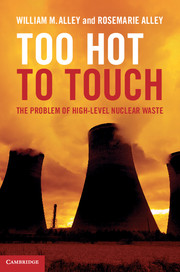Book contents
- Frontmatter
- Contents
- Acknowledgments
- List of units
- List of abbreviations
- Introduction
- Part I The problem
- Part II The mountain
- 12 The search for a geologic repository
- 13 Nevada wins the lottery
- 14 The Nevada Test Site
- 15 Yucca Mountain
- 16 How long is long?
- 17 Leaving almost no stone unturned
- 18 Surprise
- 19 Shake & bake
- 20 The project gets into hot water
- Part III No solution in sight
- Appendix Discussion questions
- References
- Index
19 - Shake & bake
from Part II - The mountain
Published online by Cambridge University Press: 05 February 2013
- Frontmatter
- Contents
- Acknowledgments
- List of units
- List of abbreviations
- Introduction
- Part I The problem
- Part II The mountain
- 12 The search for a geologic repository
- 13 Nevada wins the lottery
- 14 The Nevada Test Site
- 15 Yucca Mountain
- 16 How long is long?
- 17 Leaving almost no stone unturned
- 18 Surprise
- 19 Shake & bake
- 20 The project gets into hot water
- Part III No solution in sight
- Appendix Discussion questions
- References
- Index
Summary
Civilization exists by geological consent subject to change without notice.
Generally attributed to Will DurantLittle Skull Mountain, 12 miles (20 km) from Yucca Mountain, was suddenly alive and rocking during the week of July 4, 1992. The proximity of the 5.6 magnitude earthquake to the proposed nuclear repository caught considerable media attention. A State of Nevada spokesman called it a “wake-up call.” Many residents in the region, accustomed as they were to past nuclear detonations, slept right through the 3 a.m. event. The Department of Energy reassured everyone that the quake was well within the magnitude for which they were designing the repository. The DOE spokesman even suggested that the event was a big plus, in that it would help characterize the region's seismic hazards.
The Little Skull Mountain earthquake occurred less than 24 hours after the powerful magnitude 7.3 Landers earthquake shook the Mojave desert in California, about 180 miles (300 km) to the south. Clearly, there was a connection. Almost immediately after the Landers quake, a series of micro-earthquakes began in the vicinity of Little Skull Mountain. The Landers earthquake, recorded as the second largest in southern California in the twentieth century, definitely woke a few people up.
While the media made hay and the State raised the red flag, the Little Skull Mountain quake came as no surprise to geologists. Yucca Mountain lies in the tectonically active Basin and Range. This huge geographic province consists of small, north–south trending mountain ranges separated by nearly flat desert basins. The basins are filled with sediments eroded from the mountains over the eons. The Basin and Range includes almost all of Nevada, the western half of Utah, southeastern California, and the southern part of Arizona. G.K. Gilbert, the nineteenth-century geologist who coined the term Basin and Range, likened the ranges to an “army of caterpillars marching north out of Mexico.”
- Type
- Chapter
- Information
- Too Hot to TouchThe Problem of High-Level Nuclear Waste, pp. 287 - 296Publisher: Cambridge University PressPrint publication year: 2012



